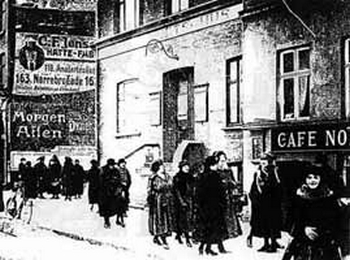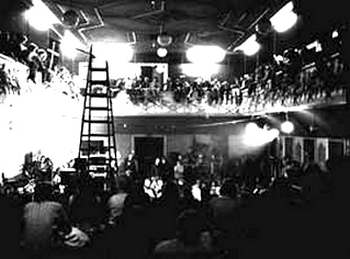History of
International Women's
Day
- Janice Murray -
 
Historic site in Copenhagen, Denmark where women from around the
world
gathered for the Second International Conference of Socialist
Women in
1910 and passed the resolution
establishing International Women's Day.
In 1910, 109 years ago, a resolution was passed by
the
Second International Conference of Socialist Women held in
Copenhagen, Denmark establishing International Women's Day. More
than 100 women delegates from 17 countries attended, among whom
were the first three women elected to the Finnish parliament. The
resolution was put forward by German communist Clara Zetkin who
had first proposed the idea of an annual demonstration in support
of working women and women's rights at the First International
Conference of Socialist Women held in Stuttgart, Germany in
1907.
This Second International Conference of Socialist
Women
reiterated the principles adopted at the First on the question of
women's suffrage. These principles established the framework for
the resolution to establish an International Women's Day that
focused on the question of women's political rights.
The document states in part:
|

German communist Clara Zetkin (1857-1933), initially proposed
International Women's Day in 1910. She was active in the Social
Democratic Party of Germany until 1916, when she co-founded the
Spartacus League of the Independent Social Democratic Party of
Germany. In 1919 she joined the Communist Party of Germany, which
she
represented in
the Reichstag from 1920-1933.
|
"The socialist woman's movement of all countries
repudiates
the limited Woman's Suffrage as a falsification of and insult to
the principle of the political equality of the female sex. It
fights for the only living concrete expression of this principle:
the universal woman's suffrage which is open to all adults and
bound by no conditions of property, payment of taxes, or degrees
of education or any other qualifications, which exclude members
of the working class from the enjoyment of the right. They carry
on their struggle not in alliance with the bourgeois Women's
Righters, but in alliance with the Socialist Parties, and these
fight for Woman's Suffrage as one of the demands which from the
point of view of principle and practice is most important for the
democratization of the suffrage."
Stating that the socialist parties in all
countries are
"bound to fight with energy for the introduction of Woman's
Suffrage" it says that the socialist women's movement must take
part in the struggles organized by the socialist parties for the
democratization of the suffrage, while at the same time ensuring
that within this fight the "question of the Universal Woman
Suffrage is insisted upon with due regard to its importance of
principle and practice."
The resolution to establish International Women's
Day
states,
"In order to forward political enfranchisement of
women
it is
the duty of the Socialist women of all countries to agitate
according to the above-named principles indefatigably among the
labouring masses; enlighten them by discourses and literature
about the social necessity and importance of the political
emancipation of the female sex and use therefore every
opportunity of doing so. For that propaganda they have to make
the most especially of elections to all sorts of political and
public bodies."
The delegates resolved,
"In agreement with the class-conscious political
and
trade
organizations of the proletariat in their country the socialist
women of all nationalities have to organize a special Woman's
Day, which in first line has to promote Women Suffrage
propaganda. This demand must be discussed in connection with the
whole women's question according to the socialist conception of
social things."
A "Woman's Day" had been organized the previous
year in
the
United States, on the last Sunday in February 1909, by the
National Women's Committee of the American Socialist Party. It
was marked by demonstrations which highlight the demand for
women's suffrage along with the rights of women workers,
particularly in the garment trade. Woman's Day honoured the
thousands of women involved in the numerous labour strikes in the
first years of the twentieth century in many cities, including
Montreal, Chicago, Philadelphia and New York. This was a period
when women entered the labour force in their thousands and
alongside working men fought to organize collectively and to
improve their brutal conditions of work.
Later in 1909, needle-trade workers in New York
City --
80
percent of whom were women -- walked off their jobs and marched
and rallied for union rights, decent wages and working conditions
in the "Uprising of 20,000." The work stoppage was referred to as
the "women's movement strike" and continued from November 22,
1909 to February 15, 1910. The Women's Trade Union League
provided bail money for arrested strikers and large sums for
strike funds during the work stoppage.
Early Celebrations of International Women's
Day
March 19, 1911 was the date set for the first
International Women's Day and, implementing the resolution
adopted at the Second International Conference of Socialist
Women, rallies were held in Austria, Denmark, Germany and
Switzerland on that day attended by more than one million women
and men. "The vote for women will unite our strength in the
struggle for socialism" was the call of these rallies. In
addition to their demand for the right to elect and be elected,
they demanded the right to work, to vocational training and to an
end to discrimination on the job. A woman socialist wrote at that
time:
"The first International Women's Day took place
in
1911. Its
success exceeded all expectation. Germany and Austria on Working
Women's Day was one seething, trembling sea of women. Meetings
were organized everywhere -- in the small towns and even in the
villages halls were packed so full that they had to ask male
workers to give up their places for the women.
"This was certainly the first show of militancy
by the
working woman. Men stayed at home with their children for a
change, and their wives, the captive housewives, went to
meetings. During the largest street demonstrations, in which
30,000 were taking part, the police decided to remove the
demonstrators' banners: the women workers made a stand. In the
scuffle that followed, bloodshed was averted only with the help
of the socialist deputies in Parliament."
The following year, women in France, the
Netherlands
and
Sweden joined in actions marking International Women's Day. In
the period leading up to the declaration of World War I, the
celebration of International Women's Day opposed imperialist war
and expressed solidarity between working women of different lands
in opposition to the national chauvinist hysteria of the ruling
circles. For example, in Europe International Women's Day was an
occasion when speakers from one country would be sent to another
to deliver greetings.
Russian women observed their first International
Women's Day
on the last Sunday in February 1913 (on the Julian calendar,
which corresponded to March 8 on the Gregorian calendar in use
elsewhere), under conditions of brutal Czarist reaction. There
was no possibility of women organizing open demonstrations but,
led by communist women, they found ways to celebrate the day.
Articles on International Women's Day were published in the two
legal workers' newspapers of the time, including greetings from
Clara Zetkin and others.
An essay written in 1920 by a woman communist
activist
at
that time described the 1913 celebration:
"In those bleak years meetings were forbidden.
But in
Petrograd, at the Kalashaikovsky Exchange, those women workers
who belonged to the Party organized a public forum on 'The Woman
Question.' Entrance was five kopecks. This was an illegal meeting
but the hall was absolutely packed. Members of the Party spoke.
But this animated 'closed' meeting had hardly finished when the
police, alarmed at such proceedings, intervened and arrested many
of the speakers.
"It was of great significance for the workers of
the
world
that the women of Russia, who lived under Czarist repression,
should join in and somehow manage to acknowledge with actions
International Women's Day. This was a welcome sign that Russia
was waking up and the Czarist prisons and gallows were powerless
to kill the workers' spirit of struggle and protest."
Women in Russia continued to celebrate
International
Women's
Day in various ways over the ensuing years. Many involved in
organizing landed themselves in Czarist prisons as the slogan
"for the working women's vote" had become an open call for the
overthrow of the Czarist autocracy.
The first issue of "The Woman Worker"
(Rabotnitsa), a
journal
for working class women, was published in 1914. That same year,
the Bolshevik Central Committee decided to create a special
committee to organize meetings for International Women's Day.
These meetings were held in the factories and public places to
discuss issues related to women's oppression and to elect
representatives from those who had participated in these
discussions and the resulting proposals to work on the new
committee.
International Women's Day 1917 in Russia

International Women's Day demonstration in 1917 at the Putilov
factory
in Petrograd.
In Russia, International Women's Day 1917 was a
time of
intense struggle against theCzarist regime. Workers, including
women workers in textile and metal working industries, were on
strike in the capital city and opposition to Russia's
participation in the imperialist war raging in Europe was
growing. On March 8 (February 23 on the Julian calendar), women
in their thousands poured onto the streets of St. Petersburg in a
strike for bread and peace. The women factory workers, joined by
wives of soldiers and other women, demanded, "Bread for our
children" and "The return of our husbands from the trenches."
This day marked the beginning of the February Revolution, which
led to the abdication of the Czar and the establishment of a
provisional government.
The provisional government made the franchise
universal, and
recognized equal rights for women. Following the October 1917
Revolution, the Bolshevik government implemented more advanced
legislation, guaranteeing in the workplaces the right of women to
directly participate in social and political activity,
eliminating all formal and concrete obstacles which previously
had meant the subordination of their social and political
activity and their subservience to men. New legislation on
maternity and health insurance was proposed and approved in
December 1917. A public insurance fund was created, with no
deductions from workers wages, that benefited both women workers
and male workers' wives. It meant that women were now treated
second to none as neither they nor their children were dependent
on spouses and fathers for their well-being.
After 1917
March 8 as International Women's Day became
official in
1921
when Bulgarian women attending the International Women's
Secretariat of the Communist International proposed a motion that
it be uniformly celebrated around the world on this day. March 8
was chosen to honour the role played by the Russian women in the
revolution in their country, and through their actions, in the
struggle of women for their emancipation internationally.
The first IWD rally in Australia was held in
1928. It
was
organized by the communist women there and demanded an eight hour
day, equal pay for equal work, paid annual leave and a living
wage for the unemployed.
Spanish women demonstrated against the fascist
forces
of
General Francisco Franco to mark International Women's Day in
1937. Italian women marked IWD in 1943 with militant protests
against fascist dictator Benito Mussolini for sending their sons
to die in World War II.
In this way, since 1917, International Women's
Day has
been
both a day of celebration of women's fight for their rights and
the rights of all and a day to militantly reaffirm the fight for
women's rights which continues to this day and opposition of
women to imperialist war and aggression. Its spirit has always
been that to win the rights of women and the fight for security
and peace, women must put themselves in the front ranks of the
fight and of governments which represent these demands.
This article was published in

Volume 49 Number 8 - March 9, 2019
Article Link:
History of
International Women's
Day - Janice Murray
Website: www.cpcml.ca
Email: editor@cpcml.ca
|






